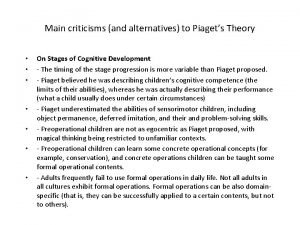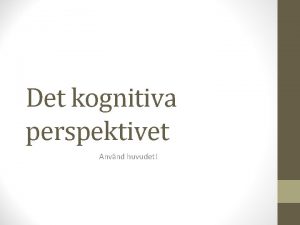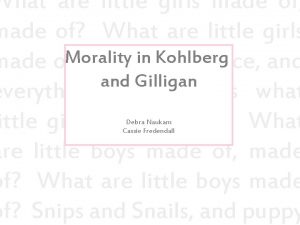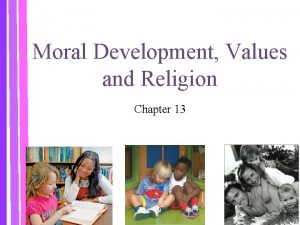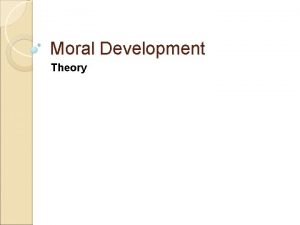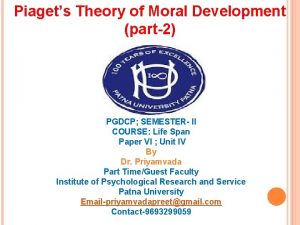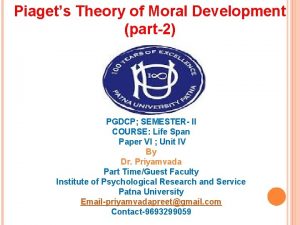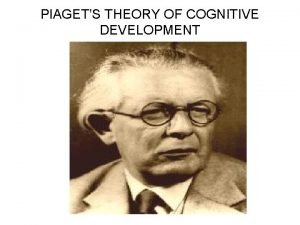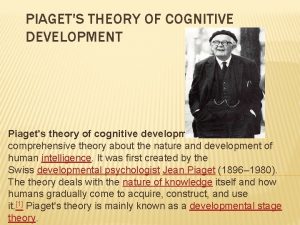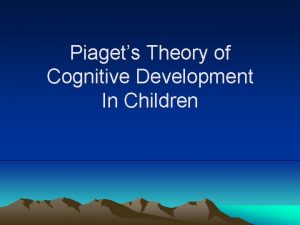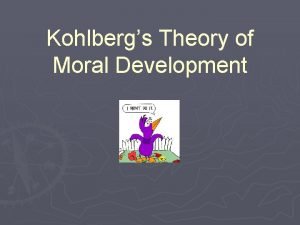Piagets Theory of Moral Development part1 PGDCP SEMESTER








- Slides: 8

Piaget’s Theory of Moral Development (part-1) PGDCP; SEMESTER- II COURSE: Life Span Paper VI ; Unit IV By Dr. Priyamvada Part Time/Guest Faculty Institute of Psychological Research and Service Patna University Email-priyamvadapreet@gmail. com Contact-9693299059

JEAN PIAGET Piaget was born on 9 August 1896 in Switzerland the oldest son of Arthur Piaget. He was Swizz Psychologist worked specially for children and for their education. His well known theories are theory of cognitive development and genetic epistemology. He died on 16 sept 1980. One of the main theory of moral development is the important one for child’s cognitive development.

PIAGET'S THEORY OF MORAL DEVELOPMENT While both Freud and Skinner focused on the external forces that bear on morality (parents in the case of Freud, and behavioral contingencies in the case of Skinner), Jean Piaget (1965) focused on the individual's construction, construal, and interpretation of morality from a social-cognitive and social-emotional perspective. [3] To understand adult morality, Piaget believed that it was necessary to study both how morality manifests in the child's world as well as the factors that contribute to the emergence of central moral concepts such as welfare, justice, and rights. Interviewing children using the Clinical Interview Method, Piaget (1965) found that young children were focused on authority mandates, and that with age children become autonomous, evaluating actions from a set of independent principles of morality. Piaget characterizes the development of morality of children through observing children while playing games to see if rules are followed.

PIAGET’S THEORY OF MORAL DEVELOPMENT Piaget’s (1932/1965) early work on children’s moral judgments focused on two aspects of moral reasoning: respect for rules and conceptions of justice. He studied developing respect for rules by playing marbles with Swiss children between ages 5 and 13. As they played, Piaget asked questions such as. Where do these rules come from? Must everyone obey a rule? Can these rules be changed? To study children’s conceptions of justice, Piaget gave them moral-decision stories to ponder. Here is one example: -

PIAGET’S STORIES Story A. Story B. A little boy who is called Once there was a little boy John is in his room. He is whose name was Henry. called to dinner. He goes One day when his mother into the dining room. But was out he tried to reach behind the door there was a some jam in the cupboard. chair, and on the chair there He climbed onto a chair and was a tray with 15 cups on it. stretched out his arm. But John couldn’t have known the jam was too high up, that there was all this behind and he couldn’t reach it. . the door. He goes in, the While he was trying to get it, door knocks against the he knocked over a cup. The tray, bang go the 15 cups, cup fell down and broke. and they all get broken. (Piaget, 1932/1965, p. 122)

PIAGET’S THEORY OF MORAL DEVELOPMENT Having heard the stories, participants were asked such questions as “ Which child is naughtier? Why? and How should the naughtier child be punished? Using these research techniques, Piaget formulated a stage theory of moral development that includes a premoral period and two moral stages.


References Ø Shaffer. David. R. , and Kipp. Katherine. , Developmental Psychology, Childhood and adolescence, 8 th edition, Wadsworth cengage learning. Ø Google images and Google search Thank you
